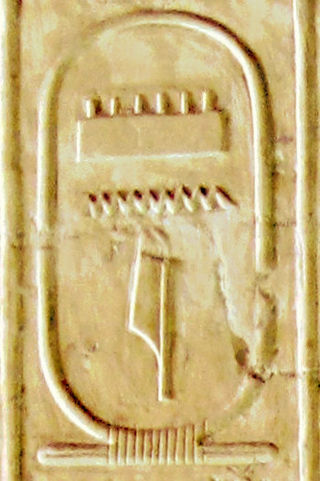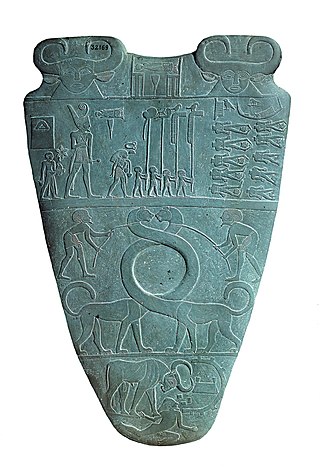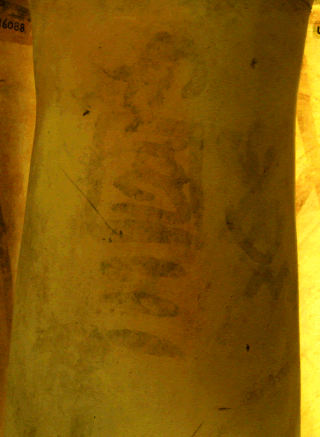Related Research Articles
Upper Egypt is the southern portion of Egypt and is composed of the Nile River valley south of the delta and the 30th parallel N. It thus consists of the entire Nile River valley from Cairo south to Lake Nasser.

Menes was a pharaoh of the Early Dynastic Period of ancient Egypt, credited by classical tradition with having united Upper and Lower Egypt, and as the founder of the First Dynasty.

Narmer was an ancient Egyptian pharaoh of the Early Dynastic Period, whose reign began at a date estimated to fall in the range 3273–2987 BC. He was the successor to the Protodynastic king Ka. Many scholars consider him the unifier of Egypt and founder of the First Dynasty, and in turn the first king of a unified Egypt. He also had a prominently noticeable presence in Canaan, compared to his predecessors and successors. Neithhotep is thought to be his queen consort or his daughter.

Nekhen, also known as Hierakonpolis was the religious and political capital of Upper Egypt at the end of prehistoric Egypt and probably also during the Early Dynastic Period.
The Early Dynastic Period, also known as Archaic Period or the Thinite Period, is the era of ancient Egypt that immediately follows the unification of Upper and Lower Egypt in c. 3150 BC. It is generally taken to include the First Dynasty and the Second Dynasty, lasting from the end of the archaeological culture of Naqada III until c. 2686 BC, or the beginning of the Old Kingdom. With the First Dynasty, the Egyptian capital moved from Thinis to Memphis, with the unified land being ruled by an Egyptian god-king. In the south, Abydos remained the major centre of ancient Egyptian religion; the hallmarks of ancient Egyptian civilization, such as Egyptian art, Egyptian architecture, and many aspects of Egyptian religion, took shape during the Early Dynastic Period.

Hor-Aha is considered the second pharaoh of the First Dynasty of Egypt by some Egyptologists, while others consider him the first one and corresponding to Menes. He lived around the 31st century BC and is thought to have had a long reign.

Scorpion II, also known as King Scorpion, was a ruler during the Protodynastic Period of Upper Egypt.

Umm El Qaʻāb is a necropolis of the Early Dynastic Period kings at Abydos, Egypt. Its modern name means "Mother of Pots" as the whole area is littered with the broken pot shards of offerings made in earlier times. The cultic ancient name of the area was (w-)pkr or (rꜣ-)pkr "District of the pkr[-tree]" or "Opening of the pkr[-tree]", belonging to tꜣ-dsr "the secluded/cleared land" (necropolis) or crk-hh "Binding of Eternity".

Iry-Hor was a predynastic pharaoh of Upper Egypt during the 32nd century BC. Excavations at Abydos in the 1980s and 1990s and the discovery in 2012 of an inscription of Iry-Hor in Sinai confirmed his existence. Iry-Hor is the earliest ruler of Egypt known by name and is sometimes cited as the earliest-living historical person known by name.

Ka, also (alternatively) Sekhen, was a Predynastic pharaoh of Upper Egypt belonging to Dynasty 0. He probably reigned during the first half of the 32nd century BC. The length of his reign is unknown.
Thinis was the capital city of pre unification Upper Egypt. Thinis remains undiscovered but is well attested by ancient writers, including the classical historian Manetho, who cites it as the centre of the Thinite Confederacy, a tribal confederation whose leader, Menes, united Egypt and was its first pharaoh. Thinis began a steep decline in importance when the capital was relocated to Memphis, which was thought to be the first true and stable capital after the unification of Egypt by Menes. Thinis's location on the border of the competing Heracleopolitan and Theban dynasties of the First Intermediate Period and its proximity to certain oases of possible military importance ensured Thinis some continued significance in the Old and New Kingdoms. This was a brief respite and Thinis eventually lost its position as a regional administrative centre by the Roman period.

Naqada III is the last phase of the Naqada culture of ancient Egyptian prehistory, dating from approximately 3200 to 3000 BC. It is the period during which the process of state formation, which began in Naqada II, became highly visible, with named kings heading powerful polities. Naqada III is often referred to as Dynasty 0 or the Protodynastic Period to reflect the presence of kings at the head of influential states, although, in fact, the kings involved would not have been a part of a dynasty. In this period, those kings' names were inscribed in the form of serekhs on a variety of surfaces including pottery and tombs.
Scorpion I was a ruler of Upper Egypt during Naqada III. He was one of the first rulers of Ancient Egypt, and a graffito of him depicts a battle with an unidentified predynastic ruler. His tomb is known for the evidence of early examples of wine consumption in Ancient Egypt.

The Gebel el-Arak Knife, also Jebel el-Arak Knife, is an ivory and flint knife dating from the Naqada II period of Egyptian prehistory, showing Mesopotamian influence. The knife was purchased in 1914 in Cairo by Georges Aaron Bénédite for the Louvre, where it is now on display in the Sully wing, room 633. At the time of its purchase, the knife handle was alleged by the seller to have been found at the site of Gebel el-Arak, but it is today believed to come from Abydos.

Double Falcon was a ruler of Lower Egypt from Naqada III. He may have reigned during the 32nd century BC. The length of his reign is unknown.

Crocodile is the provisional name of a predynastic ruler, who might have ruled during the late Naqada III epoch. The few alleged ink inscriptions showing his name are drawn very sloppily, and the reading and thus whole existence of king "Crocodile" are highly disputed. His tomb is unknown.

Elephant is the provisional name of a Predynastic ruler in Egypt. Since the incarved rock inscriptions and ivory tags showing his name are either drawn sloppily, or lacking any royal crest, the reading and thus whole existence of king "Elephant" are highly disputed.

Ny-Hor was a possible pharaoh from the Predynastic Period. His name means "The Hunter" according to egyptologist Werner Kaiser. He may have ruled during the 31st century BC.
Bull or Taurus is the provisional name for a predynastic ruler, the existence of whom is highly controversial. He is considered a ruler of the late pottery neolithic Naqada III culture of southern Egypt.

The Regalia of the Pharaoh or Pharaoh's attributes are the symbolic objects of royalty in ancient Egypt. In use between 3150 and 30 BC, these attributes were specific to pharaohs, but also to certain gods such as Atum, Ra, Osiris and Horus. In Egyptian mythology, these powerful gods were considered the original holders of royal power and the first rulers of the Nile Valley.
References
- 1 2 3 4 5 6 Secrets of Egypt, Channel 5 TV program 2/8, "Scorpion King," 20 November 2008.
- ↑ Ii, Thomas H. Maugh (2002-04-15). "The Real Scorpion King". Los Angeles Times. Retrieved 2024-02-26.
- 1 2 "Before the Pharaohs: Ancient Egypt Was Ruled by a Scorpion King, Reveals Ancient Text". Curiosmos. April 3, 2019.
- 1 2 Thompson, Jason (2008). A History of Egypt: From Earliest Times to the Present. American Univ in Cairo Press. p. 18. ISBN 978-977-416-091-2.
- 1 2 Günter Dreyer: Umm el-Qaab I .: the predynastic royal tomb U-j and its early documents (= Umm el-Qaab, 1st volume). von Zabern, Mainz 1998, ISBN 3-8053-2486-3., pp. 87 & 176.
- 1 2 3 Ludwig David Morenz: picture letters and symbolic signs. The development of the writing of the high culture of ancient Egypt (= Orbis Biblicus et Orientalis 205). Friborg 2004, ISBN 3-7278-1486-1., pp. 130–134, 172, 190–193.
- ↑ Gregory Phillip Gilbert: Weapons, warriors and warfare in early Egypt. 2004, (= BAR international series. Volume 1208). Archaeopress, 2004, ISBN 1-84171-571-9. pp. 93 & 94.